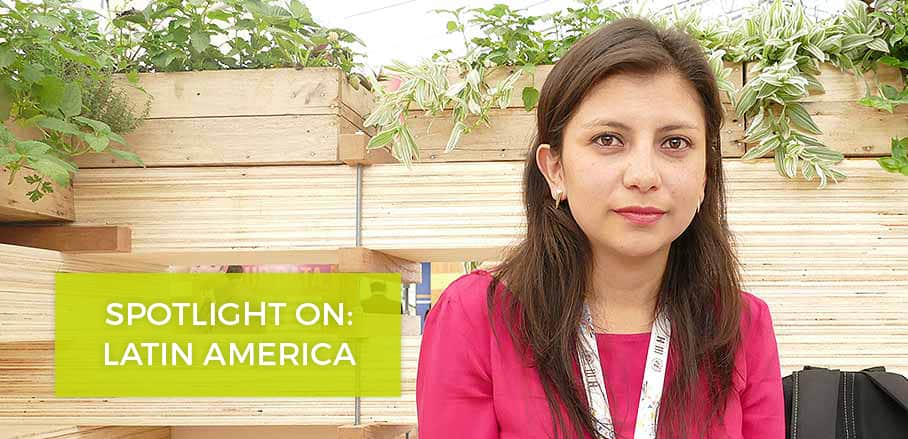“Local governments know the reality of their cities” – An Interview with Johana Hernández from the Northern Public Transport Company, Ecuador
Many cities are facing traffic-related problems and are trying to find solutions that take into consideration the local conditions. Sometimes, these solutions clash with problem solving approaches by central governments. In her interview with URBANET, Johana Hernández from the Northern Public Transport Company in Ecuador talks about such challenges and her visions for inclusive mobility.
How do people use the infrastructure in Ecuadorian cities?
In my city, Otavalo, most people walk. Luckily, our town is small and the roads are more adapted to the needs of pedestrians than cars. There are actually two streets that are only for pedestrians, so on those it is much easier to get around walking than driving. As I said, fortunately most people are interested in walking because it is a small town.
There are plans to redevelop the ring road that cuts through the city of Otavalo. Could you tell us more about this project?
Currently, we have a street that is referred to as a ring road. But in fact, it is merely a thoroughfare. That means vehicles travel on this road only to get to other cities, and thereby contribute significantly to air pollution in Otavalo. What we want is to build a bypass on the other side of the city so that those people who do not want to stay in Otavalo can drive to other cities on that road and not on the thoroughfare.
Since the thoroughfare is more like a local street, we want to redevelop it in a way that it can be used by pedestrians and have bicycle lanes and as well as rest areas. That is the proposal we have put forward; we are currently discussing its implementation with Chile and Peru. The project first emerged at a Connective Cities workshop in Mexico. At the moment, we are in the process of discussing in which city the redevelopment can be implemented. I believe Otavalo would be the most feasible option, as the city currently affected by additional pollution through misuse of a road that is intended for local, not regional traffic.
In how far are local governments in Ecuador involved in infrastructure projects and to what extent can they promote their own projects?
Unfortunately, we are currently having problems with the central government agencies because they want to redevelop our thoroughfare into an eight-lane expressway. However, we do not need an expressway, at least not at the moment. What we want is a smaller street that can be upgraded later. But the Ministry of Transport has made the construction of an eight-lane expressway a condition for giving us the funding. That is why we are currently in conflict with them.
Why do you think local governments are better equipped to look after their own local infrastructure projects than a central government?
I think local governments are always better able to take these decisions because they are the ones that know this reality. The central government may be interested in realising large-scale projects that may not always be necessary and often may not be in tune with the reality of the city. I think it would always be best for local governments to take decisions regarding local infrastructure projects because they are the ones that know the reality of their cities.
In what way can the New Urban Agenda give local governments the opportunity to develop local transport infrastructure projects?
Actually, the central government is very much interested in decentralising their functions and to confer powers on the local governments. I think that would be most beneficial. In Ecuador, the central government has already transferred the competencies in the transport sector to the local levels. Local governments, i.e. the municipalities, are already managing local mobility projects. I think it is very important that the central government gives the local governments the opportunity to also implement them.
What does good infrastructure mean for the liveability of a city?
It means a lot. It is very helpful, because infrastructure is the most important factor for including all stakeholders, e.g. persons with disabilities or people who enjoy exercise and ride their bicycles. I believe infrastructure is very important to continue building a friendly city.
How do you mainstream gender aspects into transport planning? How do you ensure safety in women’s urban mobility?
Women have actually been increasingly included in policy areas in all aspects. Nevertheless, a lot still needs to be done as there is still a lot of mistreatment of women and ignorance about their specific needs. We still have a lot of work to do to advance the subject of women’s inclusion. But we always try to consider broad inclusiveness when we implement a project.
What will urban infrastructure look like in 20 years’ time at Habitat IV, what will have changed?
I hope that we will have successfully implemented the New Urban Agenda adopted at the Habitat III conference in Quito and that in 20 years we will have achieved what we have intended. With regard to mobility, I would like to see our mobility infrastructure projects in Ecuador on the level of countries that are more advanced when it comes to using technological innovations.
